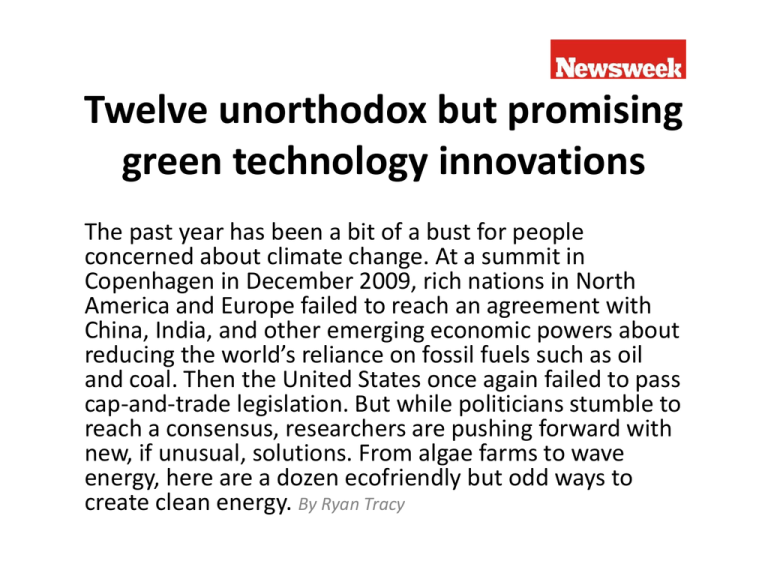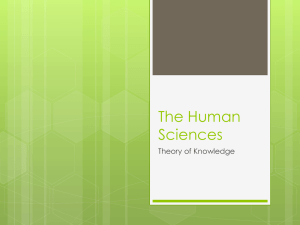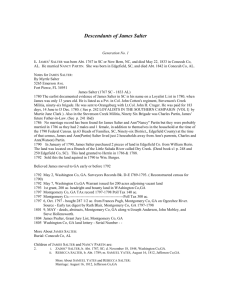Twelve unorthodox but promising green technology innovations
advertisement

Twelve unorthodox but promising green technology innovations The past year has been a bit of a bust for people concerned about climate change. At a summit in Copenhagen in December 2009, rich nations in North America and Europe failed to reach an agreement with China, India, and other emerging economic powers about reducing the world’s reliance on fossil fuels such as oil and coal. Then the United States once again failed to pass cap-and-trade legislation. But while politicians stumble to reach a consensus, researchers are pushing forward with new, if unusual, solutions. From algae farms to wave energy, here are a dozen ecofriendly but odd ways to create clean energy. By Ryan Tracy Painting the world white Most cities in the world are too black, say some scientists, Roofs are dark, roads are paved with asphalt, and all that black surface absorbs the sun’s heat. It’s called the “urban heat island” effect, and it can raise the temperature of a city by as much as 5 degrees Fahrenheit in the daytime and as much as 22 degrees at night, compared with the surrounding area. But if pavement were made of more porous or reflective materials, and if roofs were painted with lighter colors, and if cities had more shade trees, the city could reflect or block much of that heat, saving energy by cooling itself. Above, volunteers in New York paint a school roof with special white paint that will keep the roof cool and reduce the building’s energy use. Water-splitting Most solar cells are limited by a major constraint: they can’t create electricity when the sun goes down. But in a documentary called Cool It set to be released Nov. 12, Massachusetts Institute of Technology professor Daniel Nocera shares a discovery his team made two years ago. Nocera developed a cheap way to split water into hydrogen and oxygen using electricity and a few easy-to-obtain materials. It’s a breakthrough, he says, because hydrogen and oxygen can already be used to create energy in a fuel cell. He imagines it this way: during the day, a solar panel on your roof powers your home while also splitting water stored in the basement. At night, a fuel cell uses the “split” water (hydrogen and oxygen atoms) to power the house until the sun rises. Nocera hasn’t perfected the system, but already, it’s considered a giant leap for clean energy. Algae Fuel Like all plants, algae absorbs sunlight and carbon dioxide. But it also produces oil that can be refined and used as diesel or jet fuel. Its potential has scientists and energy startups searching for ways to create a genetically modified version that will produce enough oil to be a profitable cash crop. Algae also has what could be a significant advantage over other bio-fuels like corn. It can grow on dry land and salty water, meaning it won’t compete with food-producing farmland. It can grow on dry land and salty water, meaning it won’t compete with foodproducing farmland. More than 100 companies are working on a way to make this work on a large scale, but most scientists predict it will take at least a decade. Above, an algae farming pond in Virginia. Energy from nuclear waste Today’s nuclear reactors use the same basic technology that was developed in the 1950s, note researchers at Terra Power, a company trying to bring a new nuclearenergy technology to market. Older reactors need a consistent supply of enriched uranium fuel, and they spit out nuclear waste. Terra Power’s technology improves on both those points. Its “traveling wave reactor” (above) needs only a small amount of enriched fuel to start up, then it can run for years on the nuclear waste that currently gives countries a headache when they try to dispose of it. Wave Energy Harnessing wave power is not new, but proponents say its potential remains untapped more than 30 years after Prof. Stephen Salter of the University of Edinburgh invented a way to turn the power of waves into electricity. His invention, called “the duck,” rolled back and forth as the waves moved past, creating motion that the other parts of Salter’s device could capture. Today, researchers from Scotland to Oregon are working on ways to leverage that idea on a larger scale. In Oregon’s case, the goal is to have ocean-wave energy producing 2 megawatts of power—enough to power about 800 homes—by 2010, and 500 megawatts of power by 2025. Above, a wave-energygeneration device at the University of Edinburgh. Stratospheric aerosol injection Some researchers have developed ideas for cooling the earth in an effort to counter the effects of global warming. These fixes are not permanent solutions, but offer a kind of “planetary methadone” for the world’s fossil-fuel addiction, as Stanford University climatologist Steven Schneider put it. One cooling idea, illustrated above, would mimic the impact that volcanic eruptions have on the atmosphere. It stemmed from observing the aftermath of a major volcanic eruption such as Mount Pinatubo in the Philippines in 1991, which actually reduced the earth’s temperature, likely by blocking sunlight. Inventors at Intellectual Ventures, a laboratory led by former Microsoft chief technology officer Nathan Myhrvold, would re-create the impact by attaching a hose to balloons floating miles above the earth, then pumping sulfur dioxide up the hose and spraying it into the stratosphere. The dust could reflect enough sunlight to provide a temporary reprieve. Still, some scientists say the only way to really know if these technologies will work on a large scale is to actually deploy them. That hasn’t happened yet. Cloud Brightening The ship modeled above was born from the knowledge that brighter clouds reflect more sunlight, and less sunlight absorbed by the ocean could mean a cooler earth. Salter, the same scientist who designed the “Duck” wave-energy machine, designed the ship. He imagines fleets of these water vessels harnessing wind power both to sail and to spray fine particles of seawater into the sky. If the process worked properly, darker clouds would absorb the smaller droplets and become brighter as a result. “It’s a way to buy time” as the planet’s climate changes, Salters says in Cool It. Converting animal waste to fuel If there’s one thing society has no shortage of, it’s human and animal waste. It’s gross, but the good news is that there’s energy in sewage sludge. When that sludge is “digested” in large tanks that allow bacteria to break it down, methane gas is produced, which can be used to create electricity. One farmer in Pennsylvania powers his entire farm this way. Other methods also exist for extracting energy from waste, but many cities still find it cheaper to send the sludge to farmland for fertilizer or to a landfill. Below, a woman in India sorts through cow-dung cakes, which villages use as an alternative to firewood. Harnessing body heat The Matrix envisioned a fictional future in which machines enslaved humans and used the energy in their bodies to survive. Real-life scientists haven’t taken things that far, but several scientists have developed ideas for harnessing at least some of the body’s energy. The key is a small device called a thermocouple, which can generate voltage by exploiting a difference in temperature say, between your body and the air. Scientists have found that if a conductive material is placed in between hot and cold temperatures, electricity can be produced. To harness body heat, scientists imagine a small devise attached to the body that uses a thermocouple to generate a small charge, perhaps enough to power a cell phone. The Defense Department is researching whether body heat could power futuristic devices implanted in or attached to the body, like a vital-signs monitor for a soldier on the battlefield. Tornado energy Sure, wind turbines produce energy. But how fast could a wind turbine turn if it could harness a tornado like the “water spout” above? That’s the idea behind proposed power plants like the vortex engine, which would use heat rising within a chimney to create an artificial tornado. The wind would power turbines within the chimney’s walls and be tied to a base at the bottom of the shaft. “The vortex cannot break away from the base station,” says the Web site of Canadian inventor Louis Michaud. Good to know. Foot power In 2007, two MIT graduate students pioneered the piezoelectric floor, which contracts and expands with the pressure of a footstep, then captures the energy generated when the floor expands. In a crowded place, say, a Japanese train station, footsteps could generate enough power to make the process worthwhile. So far, dance clubs in Europe and train companies in Japan have used floors to generate electricity (above, a panel demonstrating the technology in Tokyo). A company called POWERLeap has also tested piezoelectric panels in Ann Arbor, Mich. Injecting water into the Earth If humans could harness the heat deep within the earth, it might provide a limitless source of clean energy. That was the promise of companies, like Seattle’s AltaRock Energy, which have designed “geothermal” energy systems. AltaRock planned to pump water deep beneath the ground, through a formation of hot rocks, and up again to the surface, where equipment would capture its heat and then send the water back down again to restart the cycle. One key snag: fears that the process might cause earthquakes, as it did on a minor scale in Sweden in 2006. But even though Altarock closed a test site in California (below) late last year, the idea of geothermal energy remains alive and the Department of Energy is funding exploratory projects.









